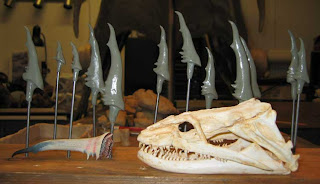Mr. Bruggers, I apologize.
I meant no disrespect, and here is the link. I have removed the rest of the text and images.
http://www.courier-journal.com/article/20090913/GREEN/909130344/1008/NEWS01
Please visit Mr. Bruggers article.
Volunteers track monarch migration as population shrinks
By James Bruggers • jbruggers@courier-journal.com • September 13, 2009
Monarch butterflies glide and soar like hawks ... more ...
Monday, September 14, 2009
Is the Loch ness Monster a Real Eel?





Steve Alten, a native of Philadelphia, holds a Bachelors degree in Physical Education from Penn State University, a Master in Sports Medicine from the University of Delaware, and a Doctorate degree in Sports Administration from Temple University. His first book, MEG; A Novel of Deep Terror was a N.Y.Times bestseller and was sold in more than a dozen countries.
I had no idea about any of his Loch Ness (real life) theories until I heard him on George Noory the other night. He's spent much time and money trying to figure out the Loch Ness mystery.
His opinion is based on a theory that Sargasso Sea species of eel has for millenia been carried by sea currents into inland water systems of Great Britain. It's true and many specimens have been found. Steve himself apprently posted a bounty for evidence, and a tooth of an eel was found in a half-eaten deer carcass on an island of a small lakelet. That tooth was huge, and allegedly this model is based on that tooth or one like it.
Eels do not die unless they spawn. However, lake-locked eels cannot spawn unless they can escape and swim back to Sargasso spawing grounds. Otherwise they live much over 100 years, and continue to grow as they eat.
They love dark, deep, cold water - and thus Loch Ness is an ideal area - plenty of food, lenty of deep, dark, cool water.
And they have teeth. And they are amphibious and can not only crawl on land, small eels can climb trees like a snake. There is no escape once they latch onto "food" which could include peoples. Eek.
These are images that folks associated with Alten have found and formed. Be afraid of the dark waters - be very afraid.
Sunday, September 13, 2009
Weird Pink Grasshopper!

11-year-old boy finds pink grasshopper
A rare pink grasshopper has been found by a schoolboy taking part in a nature trail.
By Richard Savill
Published: 7:00AM BST 11 Sep 2009
Pink grasshopper: The insect was identified by wildlife officers as an adult female common green grasshopper, which has been born pink. Photo: APEX
The insect was found by 11-year-old Daniel Tate who thought it was a flower until he saw it jump and then he realised it was a grasshopper.
The insect was later identified by wildlife officers as an adult female common green grasshopper, which has been born pink.
Daniel, who attended the wildlife event at Seaton Marshes, near Sidmouth, Devon, with his great grandfather, said: "I was looking for grasshoppers when I saw something pink.
"I thought it was a flower but I saw it moving, so I tried to catch it. It jumped and then I knew it was a grasshopper."
He added: “I was really excited to hear that no one else had found a pink grasshopper at that place before.”
Fraser Rush, nature reserves officer for East Devon District Council, said: “There are millions of common green grasshoppers but I have never seen a pink one. The female comes in a variety of colours, normally different shades of green and brown. Occasionally it tends towards purple, but this is a leap beyond that to pink.”
He added: “Pink grasshoppers are unusual but not unheard of. However the intensity of the pink in this case must make it highly unusual.”
Mr Rush said the pink grasshopper was “a natural variety of the species, albeit a rare one. It has not been caused by any mutation, or any environmental effects.”
He added: “There is a chance it will have bred already and will pass on its pink gene.”
After being studied the grasshopper was released back into the reserve.
Subscribe to:
Comments (Atom)


